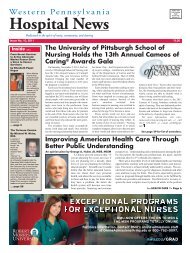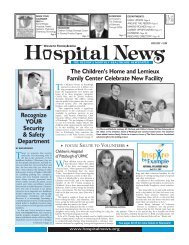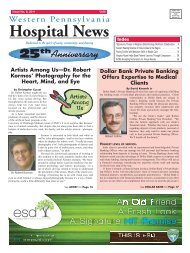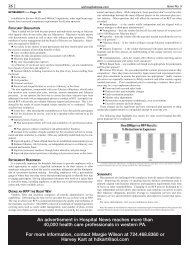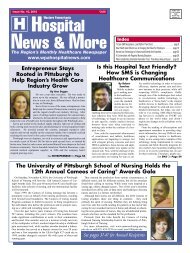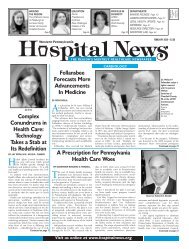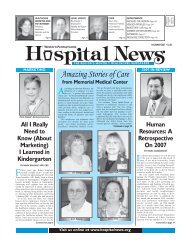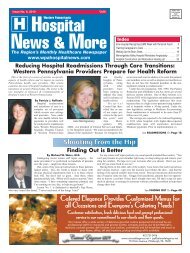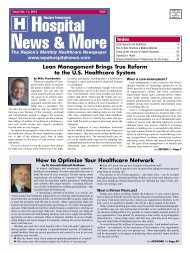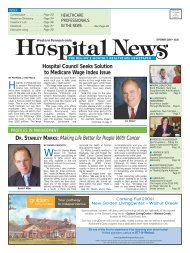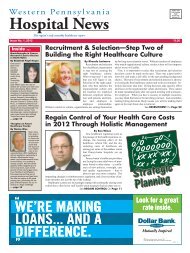McKeesport Hospital Foundation holds 33rd annual Invitational ...
McKeesport Hospital Foundation holds 33rd annual Invitational ...
McKeesport Hospital Foundation holds 33rd annual Invitational ...
You also want an ePaper? Increase the reach of your titles
YUMPU automatically turns print PDFs into web optimized ePapers that Google loves.
20 | Issue No. 5wpahospitalnews.comLaboratory Science WorkforceShortage Affected ByBaby Boomer ExitsASCP weighs in with position and surveyOften dubbed the “hidden healthcare profession,” medical laboratory scientiststoil away in hospital labs, clinics and private practices. They run pertinent diagnostictests, draw blood and examine specimen samples. They are usually the first tospot abnormities in, and as such, are a key element in the healthcare team. In manycases, lab services make up about five percent of a hospital’s budget, but leverage70 percent of all critical decision-making.Despite robust career opportunities and a decent national average salary, theprofession continues to struggle with a workforce shortage. According to the 2009American Society for Clinical Pathology Wage and Vacancy Report, there are variousreasons for this shortage: laboratory science educational programs are shuttingdown, a lack of exposure and awareness about the profession and a highturnover rate in some areas.Another workforce shortage issue is babyboomer retirement. Thirteen percent of the currentlaboratory staff is likely to retire in the nextfive years, according to the survey. Hiring qualifiedstaff to replace baby boomer workers willprove tough with fewer becoming trained. TheU.S. Department of Health and Human Servicesreports that by 2012, 138,000 lab professionalswill be needed, but fewer than 50,000 will betrained. And as boomers hit their highest healthcareconsuming years, an increasing number oflaboratory tests will exacerbate the need fortrained laboratory professionals.“The average age of the laboratory workforceMark H. Stoleris about 50 and each year steadily increases,” said ASCP President Mark H. Stoler.“ASCP is taking steps to mitigate the baby boomer exodus from the profession.We are raising awareness in the media and on Capitol Hill, National Medical LaboratoryProfessionals Week recognizes the superb work being done in the labsacross the country and our new Ambassador Program taps newer professionals toshare their passion for the profession with pre-college students.”A graying workforce presents other issues because they tend to generally leavethe work force through retirement faster than younger health personnel and aremore susceptible to adverse health and safety risks associated with shift work.OTHER ASCP WAGE & VACANCY STATS ON THE SHORTAGE INTHE NORTHEAST: Eight out of 10 hospitals (83 percent) and high-volume test sites (85 percent)reported difficulties in filling staff level MT positions. Retirement projections for the Northeast region is better than other regions,but is still projected to be around 6 percent in the next five years due to babyboomer retirement. Overall, 42 percent of labs in the Northeast are having difficulty hiring certifiedlaboratory professionals.The ASCP Wage and Vacancy Report can be viewed at http://www.ascp.org/pdf/Membership-Communications/Wage-and-Vacancy-Survey.aspx.For the ASCP position on the medical laboratory workforce shortage, visithttp://www.ascp.org/pdf/MedicalLaboratoryPersonnelShortage.aspx.Alcohol Addiction Among theBaby Boomer GenerationBy Neil CaprettoNot only are baby boomers America’s largest generation,they are one of the fastest growing groups facingalcohol addiction. For those born between 1946 and1964, the need for addiction treatment is expected tonearly triple by 2020, according to the Substance Abuseand Mental Health Services Administration (SAMH-SA). SAMHSA also reports that although problemdrinking rates have dropped sharply among generationsin the past, researchers believe baby boomers’ habitsmay not decline as much, given their generation’s social acceptance of alcohol.Although the heaviest drinking usually takes place among those 18 to 30 yearsof age, baby boomers who are consistently binge drinking may face more serioushealth problems than their younger counterparts simply because their bodies donot have the same tolerance level at an older age. For instance, three drinks at age45 may have a greater negative effect than 10 drinks at age 25. On top of that,many boomers take a variety of prescription medications. When these medicinesare combined with alcohol, it can be a recipe for disaster.Many people are able to drink alcohol responsibly without having problems. Yetfor 18 million Americans, alcohol use is a serious problem, according to theNational Council on Alcoholism and Drug Dependence (NCADD). Of the totalnumber of people who drink alcohol, about 15 percent will become alcoholdependent at some point in their lives.Risk factors for late onset alcohol addiction include a family history of alcoholism,loneliness and boredom as well as a variety of life changes such as retirement,divorce, unemployment, “empty nest syndrome,” financial losses in thestock market or death of a spouse. In addition, many boomers are facing highstress levels because they have to care for aging parents while they raise and supporttheir own children. In other cases, boomers want to reward themselves byindulging in alcohol as a way to relax. Nevertheless, one or a combination of thesefactors can spark a return to their younger “glory days” of binge drinking or bringto the surface a genetic predisposition to alcoholism.People should seek professional help if they are unable to control the amountand frequency of their alcohol use despite repeated negative consequences. Peopleoften want to deny their problem and rationalize with statements such as “It’s notthat bad” or “I don’t drink as much as someone else I know.” Yet, a slippery slopebegins when individuals are not honest with themselves and turn to alcohol as asolution for their problems.To stress the serious nature of alcohol abuse, NCADD has been sponsoringApril as “Alcohol Awareness Month” since 1987. Alcohol Awareness Month is anational campaign encouraging local communities to focus on alcoholism andalcohol-related issues through prevention efforts and screenings.The simplest alcoholic screening test is the CAGE Questionnaire, which wasdeveloped by John Ewing, M.D. The following four questions are used by manyhealthcare professionals to quickly assess an individual’s potential drinking problem.Two or more “yes answers” are highly suggestive of alcohol dependence. Have you ever felt you should Cut down on your drinking? Have people Annoyed you by criticizing your drinking? Have you ever felt bad or Guilty about your drinking? Have you ever had a drink first thing in the morning to steady your nerves orto get rid of a hangover (Eye opener)?Alcohol addiction is a disease that does not discriminate. It can affect anyoneregardless of age, race, religion or socioeconomic status. The good news is individualsand families can have hope knowing that addiction is a treatable disease.It is important that all individuals facing the disease of addiction—includingbaby boomers—choose a treatment program that holistically treats the biological,psychological, social and spiritual needs of its patients. To learn more about thetreatment options available through Gateway Rehab, call 800-472-1177 or visitwww.gatewayrehab.org. For information about recovery support services, individualscan contact Alcoholics Anonymous at www.aa.org and families can contactAl-Anon/Alateen at www.al-anon.org.Neil Capretto, D.O., F.A.S.A.M., is the medical director at Gateway RehabilitationCenter. For more information, visit www.gatewayrehab.org or call 1-800-472-1177.Submissions? Story Ideas? News Tips? Suggestions?Contact Harvey Kart at hdkart@aol.com



